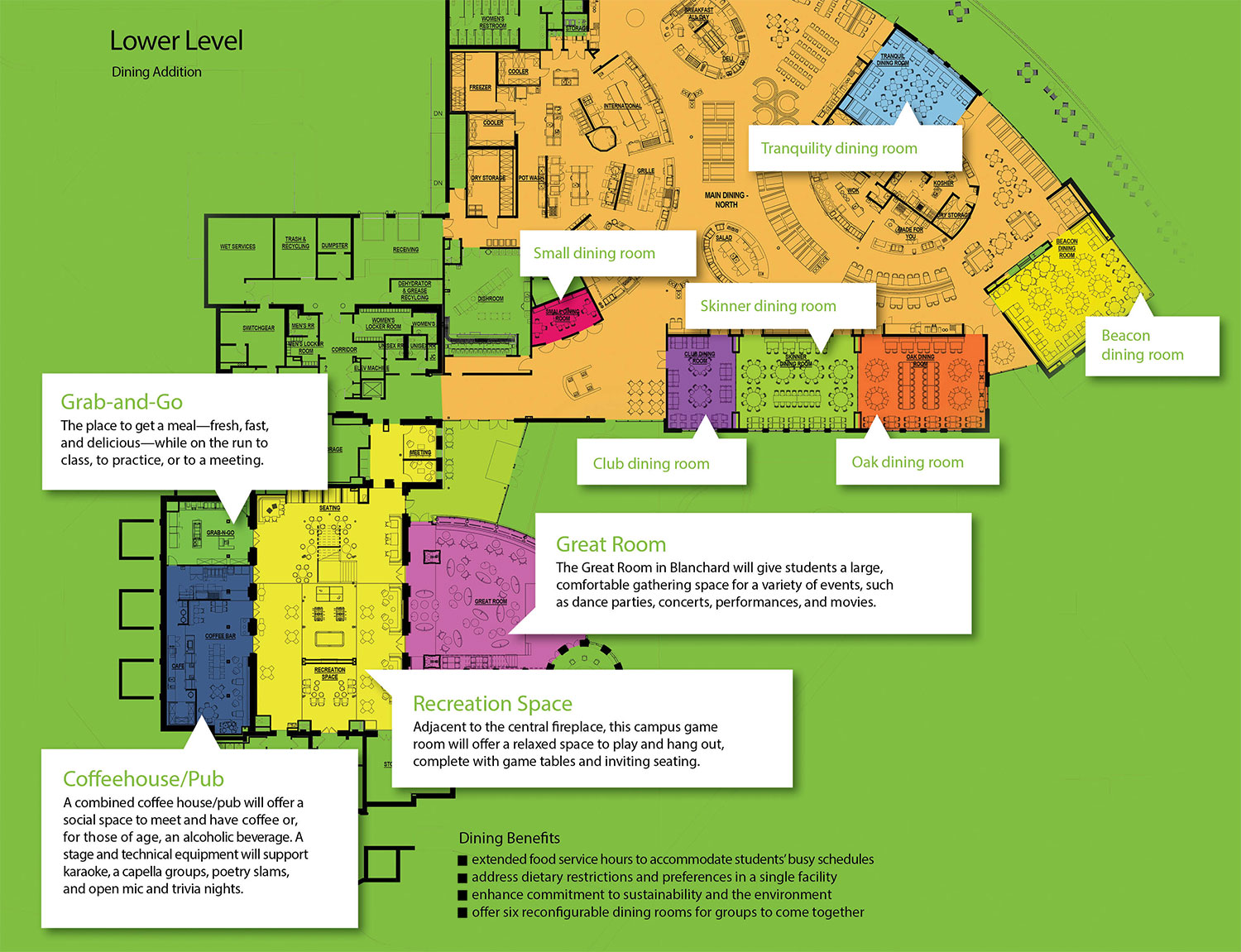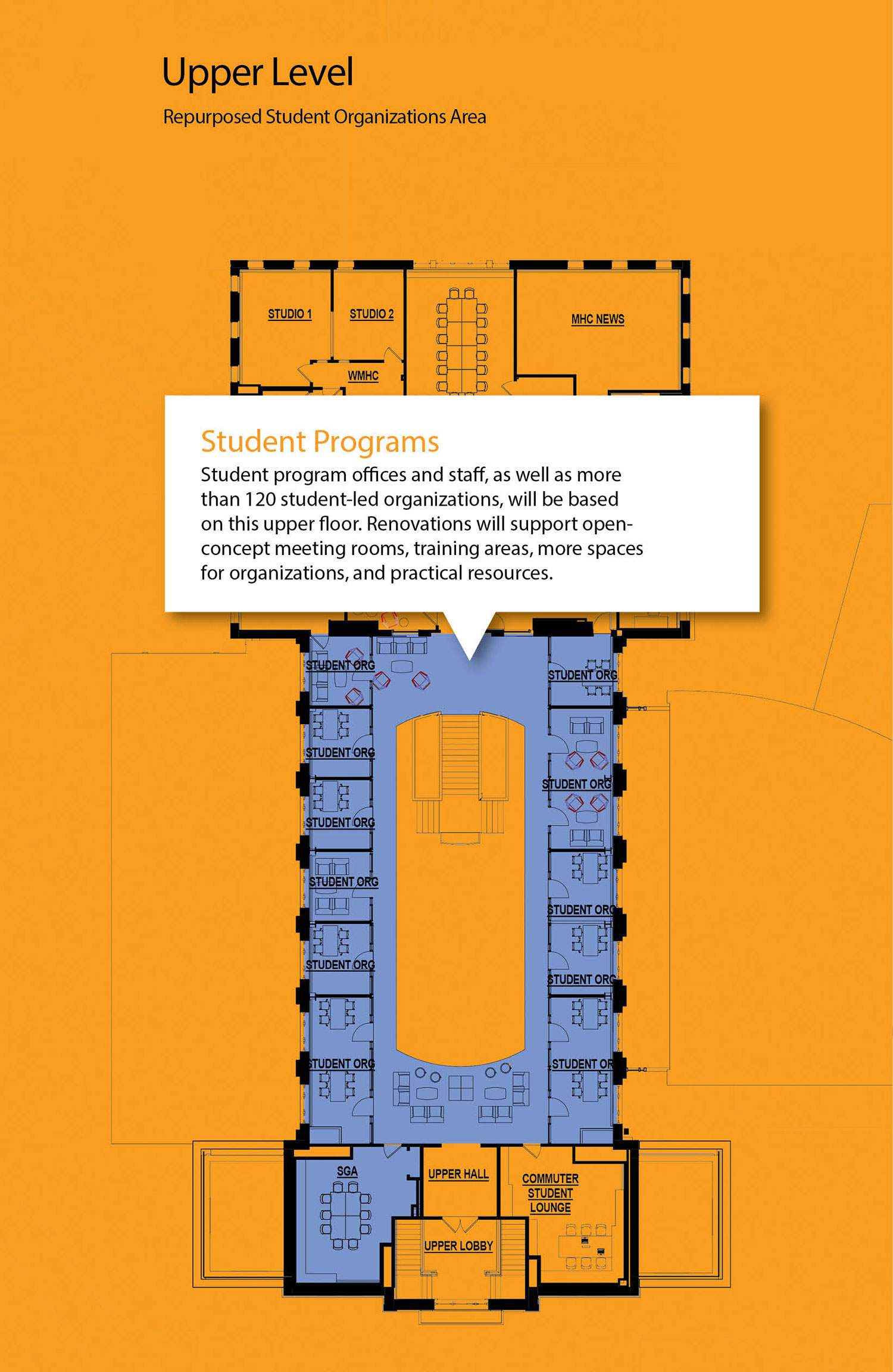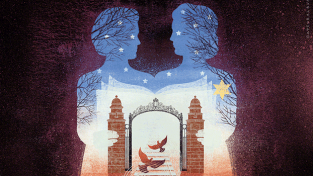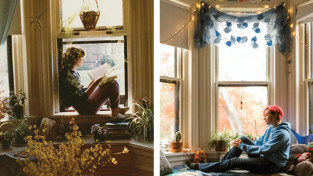Bringing the Campus Together
 The College’s new Community Center responds to the evolving needs of students with a design that is committed to preserving the MHC experience
The College’s new Community Center responds to the evolving needs of students with a design that is committed to preserving the MHC experience
On a late morning in early spring the Mount Holyoke campus is quiet. Bells from the Mary Lyon clock tower mark a quarter to twelve. Tiny pops of color peek through the trees as a few stray students and professors stroll across Skinner Green. At 12:15 p.m. the campus suddenly comes to life as morning classes adjourn. Students stream out of academic buildings or emerge sleepily from residence halls. All make their way toward one of the six dining areas across campus.
If you were to climb to the top of the clock you might notice a distinct traffic pattern emerge below. While a scattering of students may veer toward the Rockies and a couple of small groups may enter Prospect, most make their way toward Blanchard Campus Center. Inside it is buzzing—overflowing even—with students who mill about drinking coffee from Uncommon Grounds, get in (very long) lines to grab lunch, or set up camp with friends at a table in the Great Room.
Because of its central location, later hours, and take-out options, Blanchard is increasingly students’ destination for eating and socializing. Since 1950—when the building was converted from a gymnasium to offices and the College post office—Blanchard has served as a gathering space for students. Subsequent renovations added areas for socializing and the bookstore (1988) and, in response to demand for more dining options on campus, Blanchard Café (2003). Today more than one-third of the space in Blanchard is dedicated to dining services, where, according to College data, nearly half of all lunches and dinners on campus are served outside residence hall dining hours.
And when it comes to hanging out, says, Amy Yoelin ’18, a geology and English double major, “the main floor of Blanch is really the only place to gather. But it’s very small. People pull up chairs and combine tables.”
The shortage of gathering space on campus has been a growing concern for many students, who are in need of space for a variety of purposes. “There’s a new demand from student organizations,” says Topaz Mukulu ’18, an economics major from Nairobi, Kenya, who also serves as cochair of the student-advising group C.A.U.S.E.—Creating Awareness and Unity for Social Equality. The College currently has 120 recognized student-led organizations, and approximately one thousand students—or nearly half the student body—are active in at least one organization. But only about a quarter of the organizations have dedicated offices or space in Blanchard.
For the past several years, the College has been grappling with how to preserve and strengthen the sense of community that is vital to the way students experience Mount Holyoke.
“The paths between buildings are many and the connecting spaces too few,” says Acting President of Mount Holyoke Sonya Stephens. “This means that students aren’t having those repeated, unavoidable encounters that build social bonds and community.”
As Stephens sees it, the “adventure of a Mount Holyoke education” is built upon a foundation of shared moments and activities—an essential component of not only the residential college experience but of an education steeped in the liberal arts. Ensuring that these moments occur often is of utmost importance when fostering a vibrant campus community and a rigorous, well-rounded educational experience.
An anonymous alumna donor has already committed $5 million to the project and will match an additional $10 million in gifts for individual commitments that exceed $250,000. She says she is
inspired by the College’s commitment to enhance an already strong tradition of community on campus and to remain competitive among other colleges nationally.
Last year Linda Giannasi O’Connell ’69 served on a working group of students, alumnae, faculty, administrators, and consultants that was tasked with examining community around current student dining behaviors and making recommendations around future campus dining models. As a student in the 1960s, O’Connell ate all meals in her residence halls. “I was an English major,” she says, “but I knew about chemical bonds and about the poems of Ovid because I sat at a [dinner] table with chemistry and Latin majors.” O’Connell says these encounters during meals exposed her to new ideas and people from diverse backgrounds.
Today student experience around meals is different than it was even just a dozen years ago, when the College’s dining plan changed to offer meals in five residence halls and Blanchard, streamlining resources and evolving to meet student demands. Each current dining hall has a different, limited menu, and students tend to decide where to dine based on what they want to eat and where their friends are eating, or—as in the case of choosing Blanchard midday—on convenience, missing out on opportunities to interact with a broader spectrum of campus. Bobbie Green ’19 and her friends communicate via text prior to most meals. “We have a group chat on WhatsApp,” she says. “There are thirteen of us. Someone decides where they’ll be, and we meet there.”
Creating Opportunities
In February the Board of Trustees unanimously approved the expansion of Blanchard to create a unified campus center, envisioning a space where students, faculty, staff, and alumnae can join together to dine, socialize, and organize. The new building will create a hub for dining and student life services, boost visibility for student organizations, and establish a unity space dedicated to cultural understanding and civic engagement, all in a space fully compliant with the Americans with Disabilities Act. The $50 million project—half of which will be funded through philanthropic gifts, primarily through alumnae—includes an addition and renovations to all three levels of Blanchard, including a pub and coffeehouse, concert venue, student club headquarters, and themed dining rooms with views of Lower Lake and Skinner Green. Construction began after Reunion and is set to be completed by the spring of 2018.
“I’m really excited about having a large, modernized building on campus that matches with the changing times,” says Mukulu. “And people are excited by the renovations because there is more space designated to student groups, and there is more common space for meetings and collaboration than we have on campus now.”
Students across campus have been talking about the Community Center—“Super Blanch,” as they’ve named it—a building that looks to the future and literally will serve the students of the future. While renovations of Blanchard will be an integral part of the overall new Community Center, the plan also calls for a 34,000-square-foot dining addition, yet to be named. Green, who will be a senior when the center is scheduled to open, is thrilled to have a year in the new space. “It’s more than a dining hall,” she says. “It’s a bigger space, extended hours, a central location for us to come together.”
The vision for the facility calls for a series of both private and open-area dining spaces that will seat a total of about one thousand people. Each space will have a different character, such as a warm and cozy “living room” with a fireplace or a glassy, open area overlooking Lower Lake.
The dining center will allow for all types of interactions between students. For example, to encourage students to mingle, tables may be labeled or set aside for anyone interested in joining a discussion on a designated topic, such as an environmental issue, an upcoming campus event, or a favorite television show, says Cerri Banks, dean of the college and vice president for student affairs. “You can sit among strangers, and when you leave you’ll no longer be strangers, and I think that kind of opportunity will build community and greatly enhance the dining experience.”
Connecting at the Table
The expansion of Blanchard also means the remaining residence hall dining rooms will close, ending a chapter of College history much beloved by alumnae. Recent graduate Casey Accardi ’15, who served on the Community Center working group during her senior year and is a current member of the College’s Board of Trustees, understands the alumnae connection to residential dining, but she says that the way students are forming community today is not as central to dining as it historically has been. “The community experience around dining today is inherently different,” Accardi says. “Most dorms don’t contain dining halls, and everyone has the freedom to eat wherever they want with whomever they want each night. That said, I still made some of my closest friends over meals, and I’m confident the Community Center will continue to facilitate that experience.”
When O’Connell joined the working group she was skeptical about establishing one location for dining on campus. But after hearing students, faculty, and staff discuss their current experiences and challenges she came to believe in the project. She says alumnae must both cherish tradition and be open to change if they want Mount Holyoke to remain competitive and strong. “The question is, how do we honor and continue the tradition of breaking bread together as a way of forming and supporting community under modern conditions and particularly to suit the habits of prospective students?” she asks.
Investing in one central dining hall rather than updating the existing independently operating residential dining halls is also the most fiscally sound approach. Over the years the five residence hall dining areas that are still in operation have aged and are in need of updating and investment. Building the Community Center will actually reduce the overall dining hall budget and offer operational savings by consolidating and reducing the amount of equipment running on campus.
During a weekend on campus last fall, Liz Worman Bauer ’59 spent time reviewing the plans for the center in Blanchard, where they were posted for the community to review. “The Community Center with Dining project is a next and welcome step in the evolution of gathering and dining options on campus,” she says, adding that her student experience was “formal dining in the dorm with a personal linen napkin.
“I read hundreds of comments and suggestions posted by community members. Comments ranged from suggestions for use of the space to concerns about accessibility and special diets, to concerns over loss of traditions,” she says. “Common to all were desires for community and choice. The enlarged and enhanced center will provide spaces for face-to-face interactions between community members whose lives are otherwise connected virtually 24/7. I look forward to enjoying the use of the new facilities at my sixtieth reunion, if not sooner.”
Evolving for the Future
The Community Center is an integral part of Mount Holyoke’s new five-year strategic plan, presented to the Board of Trustees in May. The plan is bold, aiming to develop campus infrastructure in order to support the high-contact learning central to the Mount Holyoke experience.
“The Community Center is critical to this vision,” says Stephens. “We are a community of individuals committed to thinking together and working together. And we have a unique opportunity to connect our engagement in community-building to a building that engages our community.”
By investing in a space that facilitates intellectual and creative exchange, the College lays the groundwork for the success of its strategic plan, which focuses heavily on embracing new initiatives to support Mount Holyoke’s commitment to a robust liberal arts core, shaping and sustaining a global community, and differentiating the College from its competitors as distinct and extraordinary. At a time when the educational marketplace has grown increasingly competitive, the project will also demonstrate the College’s commitment to its facilities and help Mount Holyoke compete for prospective students.
While not all students love the new plan, younger students like Green and many of her classmates already are familiar with the model of a campus Community Center. “My friends at other colleges love the big gathering spaces they have,” she says. “We are excited that MHC is changing to meet the needs of students.”
Board of Trustees Chair Barbara McClearn Baumann ’77 agrees. “The Board’s enthusiastic and unanimous support for this project is a reflection of our commitment to finding innovative ways to respond to the needs of our current and future students, faculty, staff, and alumnae while at the same time honoring our beloved traditions,” she says. “This sustainable and accessible center will quickly become the heartbeat of this extraordinary institution.”
—By Taylor Scott with additional reporting by Sonia Scherr and Jennifer Grow ’94
This article appeared in the summer 2016 issue of the Alumnae Quarterly.
July 15, 2016













Leave a Reply